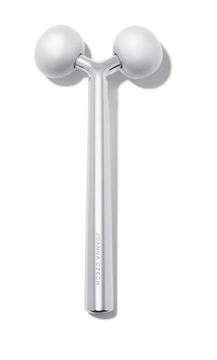After More Than a Year in Isolation, Can a Salon Appointment Provide the Care We So Desperately Crave?

Long before Anthony Fauci told the Wall Street Journal that if it were up to him, we would never go back to shaking hands again, American life had become increasingly distant—and not only because we’re all slavering over our Samsungs. We can no longer assume it is kosher to offer a colleague a hug for comfort; yoga instructors must now ask for explicit consent before adjusting a follower’s downward dog, a change that is controversial on both sides of the mat—hailed as progress by some, lamented by others. Everywhere you look, the rules of engagement are being renegotiated and everyone’s personal comfort zone is, well, personal. People have boundaries now, and it’s hard to find fault with that.
But when the global pandemic made isolation a means of survival rather than a choice, it only exacerbated what behavioral psychologist Tiffany Field, Ph.D., describes as a preexisting societal condition: We stopped touching each other a long time ago; we just didn’t notice. Our collective lack of human touch—a bodily necessity that these days is commonly described in the language of malnourishment: skin hunger, touch starved—has become its own epidemic. In a recent survey conducted by Field’s lab at the University of Miami’s Touch Research Institute, 60 percent of respondents described themselves as “touch deprived” when asked to gauge their levels of anxiety, depression, and post-traumatic stress. “It’s like prohibition,” Field says. “When something is taken away from you, you want it more than you did when you had it.”
For many women, this lapse has been a blessing—a break from the random grab at a bar, the questionable brush of an office mate, the constant navigation of whether a touch feels “right.” For others, who have spent the last year-plus in the solitude of their own homes, the absence of touch as been its own kind of trauma.
I am not alone. In fact, I am never alone. In our small town outside Amherst, Massachusetts, I have spent 14 months and counting in the constant companionship of my husband of 10 years and our sons, ages six and three. Our younger son uses my limbs as a multipurpose prop: pillow, chaise lounge, stepladder; the older one shrieks and rolls his eyes at the approach of the “kissy monster” but still happily reciprocates. Touch starved? If anything, the pandemic has left me overfed, stuffed, gorged on touch of one kind—but wanting for the kind that would require nothing of me in return and that would make me feel utterly at ease, safe enough to float a thousand miles away from the chaotic shoreline of everyday life.
This really sank in a few months ago, when I began having a recurring daydream: In it, I’m being tucked into bed by my mother—who, at the time of this writing, I have not seen in 420 days, the longest stretch in my lifetime. She comes into my bedroom, pushes the hair back from my forehead, gives my arm a gentle rub, smooths my blankets, and then shuts off the lamp and leaves me to sleep. I always zero in on her hands, savoring the way their touch makes me feel: safe, loved, looked after, unburdened. Maybe even a little pampered? Then, during a bedtime recitation of The Velveteen Rabbit to my own children, I found myself lingering a little too long on the description of the ancient skin horse—a toy so torn and tattered by generations of childhood love that his brown coat was “bald in patches...and most of the hairs in his tail had been pulled out to string bead necklaces.” I had a realization: My mother may have been awaiting vaccination 800 miles away, but Rachel, a local hair colorist, was taking new appointments.
Rachel began operating a wartime salon in the partially renovated apartment above her house last summer, a few months after Massachusetts lifted its ban on nonessential businesses. By the time I arrive, the CDC could not find fault with her protocols. We both wear masks. Her entire head is additionally obscured behind the kind of clear shield humanitarians wear to visit land mine–infested territories. There are fans whirring, windows open, and a space heater chug-chugging to keep my toes, still tucked inside winter boots, just north of frostbite. When it’s time to rinse, she leads me to a hose she has rigged to a tiny sink in an under-construction bathroom. It is the most luxurious few hours I have experienced in months.
Just being with another person in a new place was a small thrill. But the real surprise was how soothing and welcoming it felt to have someone else’s hands in my hair. As she touched my scalp, my forehead, my neck, it felt verboten, borderline erotic—or at least exceedingly rare. I had always categorized the process of periodically marching my strands back to their once-natural reddish blonde as “maintenance.” But there was nothing tedious about having several levels of my own personal need kindly and efficiently worked out by another person. As Rachel tugged away, the experience registered not as superficial, but crucial. And all I had to do was sit there! Which gave me time to think—in itself, a gift—about how this was the kind of “wellness” that had worked perfectly well for our mothers and grandmothers. Not so long ago, a good old-fashioned visit to the beauty parlor could cure a lot of ills.
A fastidious soul, Rachel did not rush. It was dark out by the time I emerged from her house into a clear, crisp evening. Cocktail hour, and I had freshly done hair! Then the COVID-era reality hit me anew: I had literally nowhere to go but home.
“Our need for touch is much more dramatic than people think,” explains David Linden, Ph.D., a neuroscientist at Johns Hopkins University and the author of last year’s Unique: The New Science of Human Individuality. “We think of touch as a secondary sense. It’s not.”
As Linden sees it, touch is an undersung but critical part of our very humanity, and while being “touch starved” is not a condition per se—there’s no way to diagnose or quantify it—the void humans have begun to pick up on during this extraordinary time is very real. Touch is the first sense to come online when we’re born, our earliest form of communication, the language we use to form our first and most lasting bonds. It has an almost mystical effect on how both our brains and bodies develop—which is why every new parent is well versed in the power of skin-on-skin contact with an infant. Touch is how we communicate love, trust, empathy. And, done right, it builds familiarity, greasing the wheels of day-in, day-out human interaction.
Touch is also our most relentless sense: You can close your eyes and cover your ears, but you can never shut down the big information-seeking envelope that is your skin. Almost every part of our body is covered in fine vellus hairs, most too fine to be seen. Nerve endings at the base of these hairs act as microscopic motion sensors—and they’re choosy, says Linden: Lightly run your finger along someone’s skin too slowly, and it gives them chills; stroke too fast, and it feels abrupt. The optimal speed is one inch per second, elaborates Linden. “That’s the caress.”
University of Miami’s Field has focused much of her research on pressure receptors that lie underneath the skin. Brain waves actually change when you’re moving the skin, she explains, noting that “moderate pressure” touch—firmer than Linden’s caress—has been linked to a slowing of the heart rate, a release of mood-boosting serotonin, and a drop in pain hormones and cortisol levels. These benefits cut both ways, she explains. In one of Field’s studies, elderly people who massaged babies experienced even more dramatic benefits—lowered stress levels, an increase in pleasure—than when they were massaged themselves.
Indeed, when facialist Joanna Czech, who notably sculpts the visages of Kim Kardashian, Amber Valletta, and Jennifer Aniston, was forced to shutter her clinics in New York and Dallas on March 14 of last year, she felt an acute sense of loss. “I did not touch anyone for almost three months,” Czech notes with evident sadness. In her 35-year career, this was her longest stretch without “slapping” a face, as her patented massage technique is lovingly referred to by her clientele—longer even than when she was healing from a broken leg or undergoing cancer treatments. When Czech was finally able to reopen her Dallas studio, the first client she touched, a woman named Laura, looked at the facialist with tears in her eyes. “She said, ‘Joanna, this thing that I’ve been coming for—I did not realize what a luxury it is,’ ” Czech says. “I had goosebumps, too. So we cried a little bit, and then we worked.”
On a Zoom call with German neuroscientist Rebecca Boehme, Ph.D., author of the 2019 book, Human Touch, I recount Czech’s experience as well as my own transcendent visit with Rachel. Boehme nods her head vigorously when I describe the way Rachel’s touch made me feel cosseted and cared for, and—however briefly—a bit more stitched together, less fragmented, more able to be generous toward my children. Boehme, too, has been at home with two kids for the past year. Suddenly we are just a couple of pandemic moms comparing battle scars. “I feel like they always want something from me!” Boehme says, noting that the previous day she got “like, two hours alone. It was…ahhh.” That’s the thing about the touch of a loved one, she continues: It builds intimacy and bonding, but it also can come fettered with expectation and need. Whereas more transactional, one-sided interactions, she continues, can transmit many of the same chemical and neurological benefits, while also scratching another human itch—one whose two-word catchphrase happens to predate “self-care” by a decade or two. Boehme leans toward her computer’s camera for a second, so that her face is closer to mine. “What you need,” she says, “is me time.”



